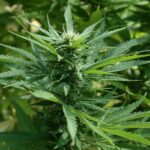How marijuana growers can teach farmers to grow food in hostile environments.
Imagine a marijuana plant on Mars.
That image showed up in a presentation by Jacklyn Green, CEO of cannabis consulting firm Agate Biosciences, at Tuesday’s Cannabis Science Conference, the nation’s largest annual gathering of marijuana scientists.
Green, a former NASA scientist, envisions a world in which data from indoor marijuana growers spurs new thinking on controlled agriculture in hostile environments.
“You are on the frontline in ways people who grow tomatoes can’t be,” she told the audience of cannabis farmers and researchers. “It starts with being a scientist in your grow.”
Green predicted humans will build a Mars colony within 100 years and will use lessons from cannabis farms to grow food inside. In the meantime, controlled environment agriculture can help provide nutrients in drought-stricken countries or areas made inhospitable by climate change.
Green also views indoor farming as a critical “hyper-local” food strategy in a rapidly urbanizing world. Growing crops inside, she said, would save untold millions on transportation and packaging costs, and keep jobs and investment in the neighborhood.
Cannabis is an ideal testing ground for these ideas. While other farmers grow vegetables in greenhouses, cannabis is one of few commercial crops raised inside buildings, in urban settings.
 Exhibitors display cannabis testing technology.
Exhibitors display cannabis testing technology.
The practice leaves little room for error.
Growers optimize the indoor environment with sophisticated HVAC systems, powerful LED lamps and nutrient-rich soils. Cleanliness is paramount: Growers coat wood in anti-microbial paint and sanitize all surfaces. They must prevent light from leaking out, while allowing fresh air inside. Temperature and humidity demand round the clock monitoring.
Several of the conference presentations demonstrated how even small-scale studies can rapidly advance the farming of cannabis and other indoor crops.
Growing outside usually yields the best results, panelists acknowledged, but some threats drive the plant indoors. Outdoor crops can face contamination from nearby fields and pests while also generating complaints from neighbors.
 An exhibit at the 2018 Cannabis Science Conference.
An exhibit at the 2018 Cannabis Science Conference.
Kat Donnelly, founder and CEO of The Sun on Demand, a plasma light technology company, advised growers to follow the principle of “biomimicry,” replicating natural conditions inside.
Other panelists noted that some cannabis strains, like Sour Diesel, can thrive indoors, developing a higher terpene and CBD content.
Autumn Karcey, CEO of cannabis design and engineering firm Cultivo, described overhauling an indoor grow to maximize profit.
She counseled growers to subdivide large warehouses into smaller rooms with less potential for contamination. Smart sensors can alert farmers via email when their plants’ water levels drop below the optimum.
She stressed the long term payoff from investing up to $200 per square foot in tightly sealed clean rooms. In a competitive market with tight profit margins, she said, every dollar counts.
Another presenter described a study comparing LED lights to High Pressure Sodium lights. For Hazy OG, the light-loving strain used in the experiment, air-cooled LEDs yielded a much higher return on investment than HPS over two harvests.
The LEDs can be lowered inches above the buds for higher intensity. That led to a higher rate of photosynthesis and higher yields.
Green applauded these studies as examples of the rigorous science lacking in marijuana cultivation. Few scientific journals focus on cannabis, and growers tend to rely on anecdotal evidence from their peers.
Growers, she said, can fill the gap in knowledge with modest citizen science projects in their own grows.
“Don’t just say you’ve got the dankest weed. Say you can prove it.”
To subscribe to Oregon Business, click here.








